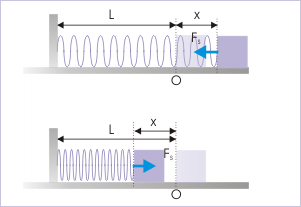For moving objects, the rate of the work done by a force (measured in joules/second, or watts) is the scalar product of the force (a vector) and the velocity vector of the point of application. This scalar product of force and velocity is classified as instantaneous power delivered by the force. Just as velocities may be integrated over time to obtain a total distance, by the fundamental theorem of calculus, the total work along a path is similarly the time-integral of instantaneous power applied along the trajectory of the point of application.
Work is the result of a force on a point that moves through a distance. As the point moves, it follows a curve
where the term
where
where
This calculation can be generalized for a constant force that is not directed along the line, followed by the particle. In this case the dot product
Example: Work Done by a Spring
Let's consider an object with mass

Spring and Restoring Force
The spring applies a restoring force (